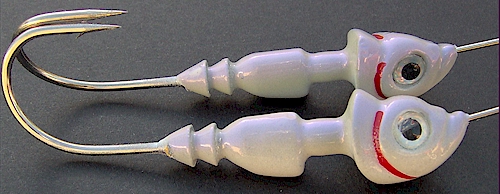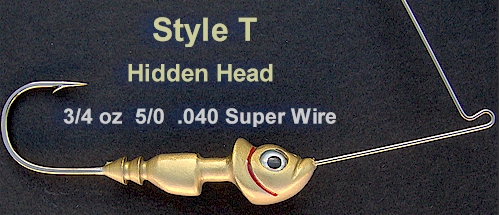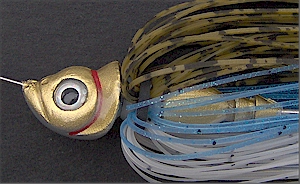-
 Spinnerbaits IV
Spinnerbaits IV

The 3/4 oz Style T Hidden Head is one of my own personal favorite and most productive spinnerbaits. This spinnerbait is h-e-a-v-y d-u-t-y. There aren't many hidden head spinnerbaits on the market to begin with, and certainly not heavy power fishing ones like this. I think one of the keys why it works so swell is that it stays consistently deeper. It really likes to stay about eight feet down even if you don't do anything to intentionally get it deeper. Of course, if you give it time to sink and work it in a slow-rolling fashion, it can get much deeper. But even on its own without doing anything special, the depth which this spinnerbait seeks is deeper than normal.
I often use such a heavier/deeper spinnerbait while having a lighter spinnerbait on a spinning rod on the deck, and I'll often alternate between the two in order to maximize the number of fish caught.. I usually start with the heavier/deeper one first, and when I feel I've had the majority of action that I am going to get on that one, then I'll go back through the productive areas with the lighter, higher-riding spinnerbait on the spinning rod, and almost always get a few more fish on the second presentation. Importantly, this "second round" are fish that would not have hit the first presentation again. Fish really do wise up to you quickly. Best odds are always on the first cast. Subsequent casts with the same lure often only serve to further reinforce that it should NOT be hit. So following through with a second different lure is a great way to catch active fish that have already rejected the first presentation.


3/4 oz Style T

3/4 oz Style T
Which Weight Head to Use When?
When a good spinnerbait bite is on, I often work with three or four different spinnerbait weight sizes tied on different rods. True, this does show fish different skirt colors and different blade configurations, but what is more important to me is that different spinnerbait sizes present alternative depths, speeds, diverse size profiles, and varying mass displacement. Just like a good mechanic who may use several different sizes of wrenches to work on a vehicle, I will use several different sizes of spinnerbaits to work a good spinnerbait bite.
- Light Spinnerbaits. I tend use the 1/4 oz spinnerbait for super slow presentations (such as in cold water), in super shallow bodies of water, or in downsized environments such as small streams and farm ponds. A 1/4 oz is not a lot of weight to counterbalance blade torque, so a 1/4 oz spinnerbait is more temperamental and prone to roll up on its side more than heavier spinnerbaits. A 1/4 oz is usually built with shorter wire arms and smaller blades to counteract roll. If light line is appropriate for the fishing conditions, then lighter line (for example, 8 lb test) can help add stability with a 1/4 oz spinnerbait. The shorter wire arms, smaller head shape, smaller hook (3/0 is often ideal), smaller blades plus trimming the skirt short gives you a super compact, super slow-moving presentation for wary bass in shallow water.
- Medium Light. I tend to use a 3/8 oz spinnerbait to ride high, tossed tight up on the very shoreline or over emergent shoals. This is the smallest size I go with most days. This size I use more slowly and I tend to keep it up high near the surface. This gives me slowness, smallness and more of a high-floating, free-swimming buoyant presentation. I'll tend to pick this size for shallow water, say anything under six feet deep. Since I am using this size in shallow water, which often has a lot of cover, there are often panfish present. So I often use sunfish colors here, or a watermelon/brown color. This 3/8 oz spinnerbait is a "fixture" for me, meaning I rarely take it off. It is always worth a few casts in any fishing spot. Because it has a smaller, more natural presence.
- Medium Spinnerbaits. The 1/2 oz spinnerbait serves me best most of the time. It's ideal when depth ranges from 6 to 18 feet deep. Averaged over a season, there is no doubt I make more casts with the 1/2 oz than with all other spinnerbait sizes. On days when I have had a good morning bite with the 1/2 oz, but the bite starts to shut down, that is when I tend to try the 5/8 oz, especially in a hidden head style. The 5/8 oz will run a little deeper, a little faster, and I will tend to fish it a little further out from shore after a shallow morning spinnerbait bite disappears.
- Medium/Heavy Spinnerbaits. I make fewer casts with the 3/4 oz on an average day. Even still, it is invaluable whenever I need a slightly deeper retrieve, faster speed or a little extra bulk. Keep in mind, a 3/4 oz has a bigger head, bigger hook, can handle more skirt and counterbalance more blade force than a 1/2 oz. What I mean is, the 3/4 oz can take more or bigger blades than the 1/2 oz. Also, when it becomes very windy, it may become necessary to go to the 3/4 oz. The 1/2 oz can be less effective at those times in terms of being able to cast it, control the line and feel the spinnerbait.
- Heavy Spinnerbaits. I make much use of 1 oz spinnerbaits - even in one foot of water. In shallow water, the 1 oz spinnerbait has a ton of presence. It is a big fish bait. Most anglers will never try this. So if you dare to try it, you can have all the 1 oz spinnerbait biters all to yourself in shallow water. Trust me, it works. I've hauled in many monster bass on 1 oz spinnerbaits in 1-2 feet of water.
I also use the one ounce as a bottom-bouncing presentation, slow rolling it 20 to 30 feet deep. Many anglers know about deep slow rolling, but few ever do it or they give up too quickly. It really is a game of patience. And the exact opposite, I use 1 oz blades as an extreme topwater presentation burning it back as fast as possible. Again, few anglers do this. Despite its lack of popularity, the 1 oz spinnerbait, no matter how you use it, tends to be a big bass presentation.
- Extra Heavy Spinnerbaits. As heavy as you can practically cast for bass is 1-1/2 ounces. It really requires a specialized rod and can be physically strenuous to use except for short period even for anglers in tiptop physical shape.
 Posting Permissions
Posting Permissions
- You may not post new threads
- You may not post replies
- You may not post attachments
- You may not edit your posts
-
Forum Rules







 Reply With Quote
Reply With Quote